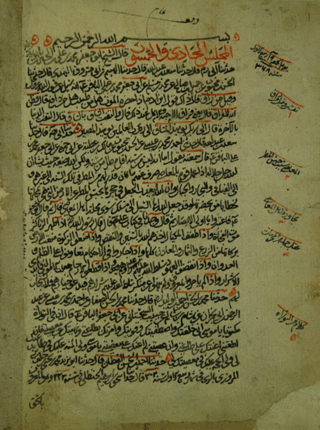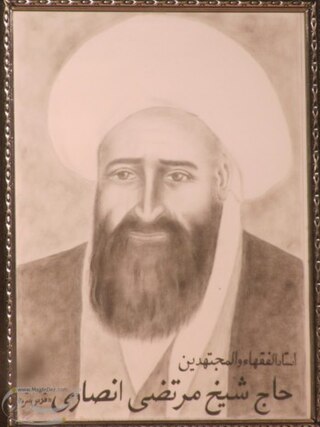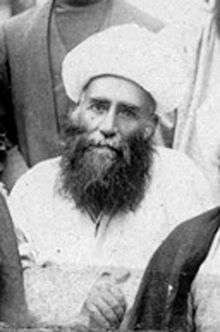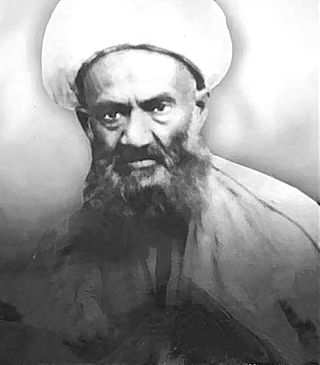A hawza or ḥawzah ʿilmīyah is the collective term for a madrasa where Shi'a Muslim scholars are educated.

The Isfahan School is a school of Islamic philosophy. It was founded by Mir Damad and reached its fullest development in the work of Mulla Sadra. The name was coined by Seyyed Hossein Nasr and Henry Corbin.

Bihar al-Anwar is a comprehensive collection of hadith compiled by Shia scholar Muhammad Baqir Majlisi. It is a hadith collection as the secondary source used beside the Four Books.
Akhbarism is a minority school of Twelver Shia Islam. The term is usually used in contrast to the majority branch of Twelver Shia – the Usuli. Like the Usulis, they follow the Quran and Hadith, but unlike them, Akhbari rejects the use of reasoning by trained Islamic jurisprudents (faqih) to derive verdicts in Islamic law, maintaining it is forbidden (haram) to follow the legal rulings of anyone but one of the "Fourteen Infallibles" of Twelver Islam.
The Shia view of the Qur'an differs from the Sunni view, but the majority of both groups believe that the text is identical. While some Shia disputed the canonical validity of the Uthmanic codex, the Shia Imams always rejected the idea of alteration of Qur'an's text. Only seven Shia scholars have believed in omissions in the Uthmanic codex.

Mohammad Baqer Majlesi, known as Allamah Majlesi or Majlesi Al-Thani, was an influential Iranian Twelver Shia scholar and thinker during the Safavid era. He has been described as "one of the most powerful and influential Shi'a ulema of all time", whose "policies and actions reoriented Twelver Shia'ism in the direction that it was to develop from his day on."

Muḥammad bin al-Ḥasan bin ʿAlī bin al-Ḥusayn al-Ḥurr al-ʿĀmilī al-Mashgharī, commonly known as Al-Ḥurr Al-ʿĀmilī, was a prominent Twelver Shia muhaddith. He is best known for his comprehensive hadith compilation known as Wasa'il al-Shia and as the second of the “Three Great Muhammads” in later Shi’a Islamic history.

Grand Ayatollah Sheikh Murtadha al-Ansari al-Tostari (1781–1864),, also transliterated as Mortaza Ansari Shushtari, was a Shia jurist who "was generally acknowledged as the most eminent jurist of the time."
Makhzan al-Irfan fi Tafsir al-Quran is a 15 volume tafsir by the Twelver Shia Islamic scholar and the only mujtahida of 20th century Banu Amin.

Mohammad Taqi Amoli (1887—1971) was an Iranian Shia jurist, philosopher and mystic.
Al-Sayyid Moḥammad Mehdī Baḥr al-ʿUlūm or Bahrululoom (Persian: سید محمدمهدی بحرالعلوم) was a mystic and a Shiite religious authority in the 12th and 13th centuries AH.

Mirza Husain Noori Tabarsi popularly known as Muhaddis Noori / Al-Mohaddith Al-Noori, was a Shi'a Islamic Scholar and Shi'a Renaissance.
Muḥammad Sāliḥ al-Māzandarānī, He was Shia Islamic scholar and jurist, He was the author of a ten-volume commentary, Sharḥ Uṣūl al-Kāfī, on the first of the Four Books (hadiths) of Shi'a Islam.

Grand Ayatollah Sheikh Muhammad-Hasan al-Najafi, also known as Sahib al-Jawahir, was a prominent Shiite religious authority and author. He was most known for his books of Jawahir al-Kalam Fi Sharh Shara'i' al-Islam, a 42-volume work on fiqh.

Hasan Ali Nukhudaki Isfahani was a Shi'a muslim scholar and Sufi mystic who practiced asceticism. He also studied astronomy and mathematics.
The distinction between soul and spirit in the Quran and hadith has rarely been considered by commentators, so that these two words are used interchangeably and synonymously. However, some theologians and scholars of religious scripture insist on the difference between the soul and the spirit and their order of existence. This difference in philosophical discussions is of little concern because of its specific applications, but in Quranic culture the distinction is debatable. There are many reasons that have made this topic less controversial but the most important ones are the lack of scientific evidences, and the dispersion of ideas.

The Isfahan Seminary is one of the oldest seminaries in Isfahan, Iran. Currently, more than 40 schools in Isfahan province are under the supervision of the Management Center of Isfahan Seminary and the leadership of the supreme authority of Grand Ayatollah Hossein Mazaheri.
Mohammad Sa'id Ashraf Mazandarani, commonly known as Ashraf Mazandarani, was one of the last prominent Persian poets and calligraphers at the court of Mughal India. He was born into a scholarly family in Mazandaran, a northern province of Safavid Iran.His father, Mohammad Salih al-Mazandarani, was a famous Shia Islamic scholar and jurist and his mother, Amina Begum Bint al-Majlisi, was a female Safavid mujtahideh.
Muhammad-Hadi Mazandarani was a prominent author and calligrapher of the late Safavid period. He was also known by the names Agha Hadi and Hadi Motarjem. He was recognized among scholars and ascetics of his time.









